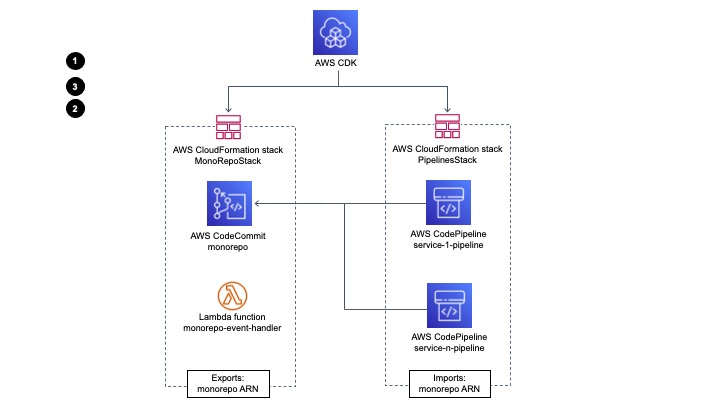This solution allows a mono-repository, which is composed of multiple services, have different CI/CD pipelines for each service. The solution detects which top level directory the modification happened and triggers the AWS CodePipeline configured to that directory.
This repository contains a AWS CDK project with two stacks: MonoRepoStack and PipelinesStack.
MonoRepoStack is responsible for creating the AWS CodeCommit monorepo and the AWS Lambda with the logic to trigger the different pipelines. It is core part of the solution and doesn't need to be modified by the stack's user.
PipelinesStack is the stack where the users are going to define their pipeline infrastructure. This repository comes with a demo and hotsite pipelines that deploys two static websites using S3 and CloudFront.
It contains the CDK Stack that creates the CodeCommit monorepo, AWS Lambda and all the logic needed to start a specific AWS CodePipeline according to a modified file path inside the monorepo. This directory is designed to not be modified. CodeCommit is going to be created with a sample project structure defined in monorepo-sample directory.
It contains a project structure that is going to be committed to CodeCommit after it is created. It comes with two simple static websites inside the directory.
It contains the files with the definition of each service pipeline.
There is two examples inside this direcctory: pipeline_demo.py and pipeline_hotsite.py, wich demonstrates how a pipeline should be defined. It deploys the demo and hotsite websites inside the monorepo-sample.
Stack's users are going to do their work inside of this directory, creating new python classes child of ServicePipeline class and implement the abstract methods: pipeline_name() and build_pipeline().
This file contains the link between each microservice directory and its pipeline definition:
service_map: Dict[str, ServicePipeline] = {
# folder-name -> pipeline-class
'demo': DemoPipeline(),
'hotsite': HotsitePipeline()
}To use this solution, you need the following:
- Python 3
- pip (package installer for Python), which already comes with Python 3 distribution: https://pip.pypa.io/en/stable/
- AWS CDK
- Clone this repository
- Create virtualenv and install dependencies:
make install
- Bootstrap the account and region for CDK:
make bootstrap account-id=<your-account-id> region=<desired-region>
Since this MonoRepoStack won't be modified, it should be deployed once.
This stack accepts the following parameter:
| Parameter name | Default Value | Type |
|---|---|---|
| MonorepoName | monorepo-sample | String |
To deploy the stack with default parameter values, type the following command:
make deploy-core
To deploy the stack with custom parameters, type the following command:
make deploy-core monorepo-name=<repo_name>
You can confirm whether the resources were correctly created by getting information about the monorepo codecommit repository:
aws codecommit get-repository --repository-name <repo_name>
This stack creates the AWS CodeCommit where your monorepo is going to be stored. Therefore, don't run
cdk destroy MonoRepoStackafter you have started to push modifications into, otherwise you are going to loose your remote repository.
This stack must be deployed after MonoRepoStack has already been deployed. It is going to grow accordingly to new microservices added into the monorepo code base.
To deploy it, type the following command:
make deploy-pipelines
PipelinesStacks deployment prints the services URLs at the end of its execution:
Outputs:
PipelinesStack.demourl = <distribution id>.cloudfront.net
PipelinesStack.hotsiteurl = <distribution id>.cloudfront.netYou can check the Demo and Hotsite services working by accessing the above URLs.
If you want to deploy both stacks on the same time, you can execute the following command for executing the deploy:
make deploy monorepo-name=<repo_name>
If you dont have a connection with the CodeCommit in your account yet, please follow the instructions of the offical documentation here.
In order to create a new pipeline for a new service (my-service), you should follow the bellow steps:
- Create a new python file inside the pipelines directory:
myservice_pipeline.py - Create a class
MyServicePipelineand declareServicePipelineas its super class.class MyServicePipeline(ServicePipeline): def pipeline_name(): return 'my-service-pipeline' def build_pipeline(): # Define your CodePipeline here
- In
monorepo_config.py, import myservice_pipeline module:from pipelines.myservice_pipeline import MyServicePipeline
- Modify
service_mapvariable inside themonorepo_config.pyfile and add the map folder -> Service Class:{ # ... other mappings 'my-service': MyServicePipeline() } - Redeploy PipelinesStack:
make deploy-pipelines
- Inside your monorepo, edit the json file
monorepo-main.jsonand add the new mapping:{ // ... other mappings "my-service": "my-service-pipeline" }
- Inside your monorepo, include the source code for the new service under a folder named
my-service. - Commit and push the modification made in steps 6 and 7.
For deleting your stacks, execute the following command:
make destroy
After executing the command, on the Amazon S3 console, delete the buckets associated with the your pipelines starting with the following name: pipelinesstack-codepipeline*.
To delete a bucket, first you have to empty it and then delete it.
See CONTRIBUTING for more information.
This library is licensed under the MIT-0 License. See the LICENSE file.

